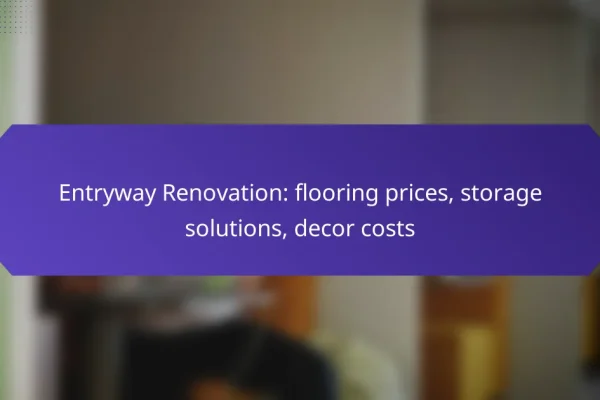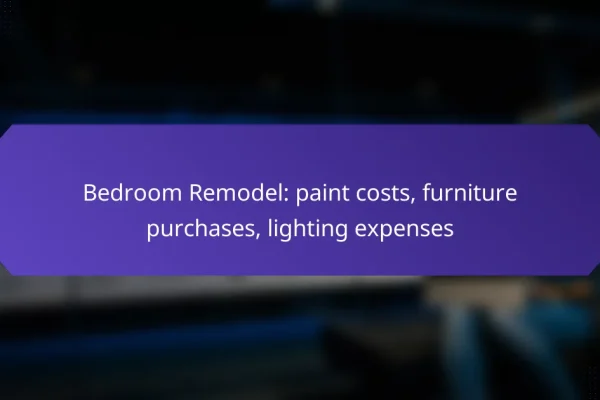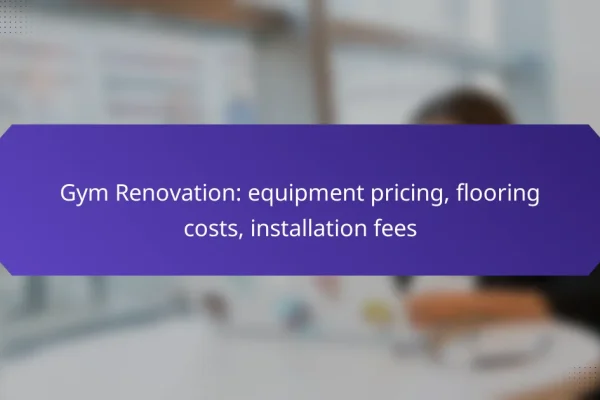What are the costs of kitchen renovations in major US cities?
The costs of kitchen renovations vary significantly across major US cities, influenced by local labor rates, material costs, and design choices. Homeowners can expect to spend anywhere from low tens of thousands to over a hundred thousand dollars, depending on the extent of the renovation and the city in which they reside.
Average cost range in New York
In New York City, kitchen renovations typically range from about $25,000 to $75,000. Factors such as the size of the kitchen, choice of materials, and labor costs contribute to this wide range.
High-end renovations, which may include custom cabinetry and premium appliances, can exceed $100,000. It’s essential to budget for permits and potential structural changes, which are common in older buildings.
Average cost range in Los Angeles
Los Angeles kitchen renovations generally fall between $20,000 and $60,000. The cost can vary based on the neighborhood and the complexity of the project.
For upscale renovations, homeowners might spend upwards of $80,000, especially if they opt for luxury finishes and smart home technology. Always consider local building codes and regulations when planning your renovation.
Average cost range in Chicago
In Chicago, homeowners can expect to invest between $15,000 and $50,000 for kitchen renovations. The city’s competitive labor market and material availability can affect these costs.
For more extensive remodels, costs can reach $70,000 or more, particularly if the renovation involves significant layout changes or high-end materials. It’s advisable to get multiple quotes from contractors to ensure a fair price.
What are the costs of bathroom renovations in the UK?
The costs of bathroom renovations in the UK can vary significantly based on factors like location, size, and the extent of the work required. On average, homeowners can expect to spend anywhere from £3,000 to £10,000 for a complete renovation, with high-end projects exceeding this range.
Average cost range in London
In London, the average cost for a bathroom renovation typically falls between £5,000 and £15,000. Factors such as the choice of materials, labor costs, and design complexity can push prices higher. For example, luxury fixtures and custom designs can easily elevate the budget beyond £15,000.
When planning a renovation in London, it is crucial to consider the potential for additional costs, such as permits and unexpected repairs. Always allocate a contingency budget of around 10-20% for unforeseen expenses.
Average cost range in Manchester
In Manchester, bathroom renovation costs are generally lower, ranging from £3,000 to £8,000. This price range reflects the city’s more affordable labor and material costs compared to London. Basic renovations can be completed within this budget, while more extensive upgrades may require additional funds.
Homeowners in Manchester should also factor in the potential need for plumbing or electrical updates, which can add to the overall cost. It’s advisable to obtain multiple quotes from contractors to ensure competitive pricing and quality work.
What factors influence renovation costs?
Renovation costs are influenced by several key factors, including material quality, labor rates, and the overall project scope. Understanding these elements can help homeowners budget effectively and make informed decisions throughout the renovation process.
Material quality
The quality of materials chosen for a renovation significantly impacts costs. Higher-quality materials, such as premium flooring or custom cabinetry, can increase expenses but often provide better durability and aesthetics.
For example, opting for hardwood flooring instead of laminate can raise costs by several hundred dollars per room. It’s essential to balance quality with budget constraints to achieve the desired outcome without overspending.
Labor rates
Labor rates vary widely depending on location, the complexity of the work, and the experience of the contractors. In urban areas, labor costs may be higher due to demand, while rural regions might offer more competitive rates.
Homeowners should obtain multiple quotes from contractors to compare labor costs effectively. Additionally, consider the potential trade-offs between hiring less expensive labor and the quality of work delivered.
Project scope
The scope of the renovation project plays a crucial role in determining overall costs. A minor update, such as painting or replacing fixtures, will typically be less expensive than a full remodel that involves structural changes.
Clearly defining the project scope before starting can help avoid unexpected expenses. Create a detailed plan outlining all desired changes and prioritize them to stay within budget while achieving the most impactful results.
How do renovation costs vary by type?
Renovation costs can differ significantly based on the type of project, with factors such as scope, materials, and labor influencing the overall expense. Understanding these variations is crucial for budgeting effectively and making informed decisions about home improvements.
Cost comparison: kitchen vs. bathroom
Kitchen renovations typically range from moderate to high costs, often between $10,000 and $50,000, depending on the extent of the work and the quality of materials used. In contrast, bathroom renovations usually fall within a lower range, often between $5,000 and $25,000, making them a more budget-friendly option.
When comparing these two types of renovations, consider the complexity of the project. Kitchens often require more extensive plumbing and electrical work, which can drive up costs. On the other hand, bathrooms may involve less structural change, but high-end fixtures can quickly increase expenses.
Cost comparison: full home renovation vs. partial
A full home renovation generally costs significantly more than a partial renovation, often starting from $50,000 and going well into six figures, depending on the home’s size and condition. Partial renovations, such as updating a single room or area, can range from $10,000 to $40,000, making them more accessible for homeowners on a budget.
When deciding between full and partial renovations, assess your goals and the condition of your home. A full renovation can enhance overall property value and aesthetics but requires a larger investment. Conversely, partial renovations allow for targeted updates that can refresh your living space without the financial burden of a complete overhaul.
What are the financing options for renovations?
Financing options for renovations include various methods that homeowners can use to fund their projects. Common choices are home equity loans, personal loans, and credit cards, each with distinct features and considerations.
Home equity loans
Home equity loans allow homeowners to borrow against the equity they have built in their property. Typically, these loans offer lower interest rates compared to unsecured loans because they are secured by the home itself.
When considering a home equity loan, it’s important to evaluate the amount of equity you have, as lenders usually require at least 15-20% equity. Additionally, be mindful of the potential risks, as failing to repay the loan could result in losing your home.
Personal loans
Personal loans are unsecured loans that can be used for renovations without needing to leverage your home. They usually have fixed interest rates and repayment terms, making budgeting easier.
However, personal loans often come with higher interest rates than home equity loans. Borrowers should compare rates from multiple lenders and consider their credit score, as it significantly impacts the loan terms offered.
Credit cards
Using credit cards for renovations can be convenient, especially for smaller projects or quick purchases. Many credit cards offer rewards or cash back, which can be beneficial if managed wisely.
However, credit cards typically have higher interest rates than other financing options. It’s advisable to pay off the balance quickly to avoid accumulating high interest charges, and consider any promotional offers that may provide lower rates for a limited time.
What are the hidden costs of renovations?
Hidden costs of renovations can significantly impact your budget, often arising unexpectedly during the project. These expenses may include permits, unforeseen repairs, and design fees that are not always accounted for in initial estimates.
Permits and inspections
Obtaining the necessary permits and passing inspections is a crucial part of many renovation projects. Depending on your location, permit costs can range from a few hundred to several thousand dollars, especially for major structural changes.
It’s essential to check local regulations before starting any work, as failing to secure the proper permits can lead to fines or even the requirement to undo completed work. Always factor these costs into your overall renovation budget.
Unexpected repairs
Unexpected repairs often arise when renovations reveal underlying issues, such as plumbing leaks or structural damage. These repairs can add significant costs, sometimes increasing your budget by 10-20% or more.
To mitigate these risks, consider conducting a thorough inspection of your home prior to starting renovations. This can help identify potential issues and allow for a more accurate budget estimate.
Design fees
Hiring a designer can enhance the quality of your renovation but also adds to the overall cost. Design fees typically range from 5-15% of the total renovation budget, depending on the complexity of the project and the designer’s experience.
When planning your renovation, weigh the benefits of professional design against the costs. If budget constraints are tight, consider using online design tools or consulting with designers for a limited scope to keep expenses manageable.
What are the trends in renovation costs for 2024?
In 2024, renovation costs are expected to rise due to increased material prices and labor shortages. Homeowners should anticipate a range of 5-15% higher costs compared to previous years, depending on the type and scope of the renovation.
Kitchen Renovations
Kitchen renovations typically account for a significant portion of a home’s renovation budget. In 2024, costs for a mid-range kitchen remodel can range from $15,000 to $30,000, influenced by factors such as material choices and labor rates.
When planning a kitchen renovation, consider the layout and functionality. Open-concept designs may require structural changes, increasing costs. Prioritize high-impact areas like countertops and cabinetry for the best return on investment.
Bathroom Renovations
Bathroom renovations are often more affordable than kitchen remodels, with average costs ranging from $10,000 to $20,000 in 2024. The price can vary based on fixtures, finishes, and whether plumbing needs to be relocated.
Focus on essential upgrades such as energy-efficient fixtures and modern tiles. Small changes, like new lighting or a fresh coat of paint, can also enhance the space without significant expense.
Living Room Renovations
Living room renovations can vary widely in cost, generally falling between $5,000 and $25,000. Factors include the extent of changes, such as new flooring, built-ins, or structural modifications.
Consider the overall aesthetic and functionality when renovating a living room. Investing in quality furniture or smart home technology can improve both comfort and value. Avoid over-personalizing the space to maintain broader appeal.
Exterior Renovations
Exterior renovations, including siding, roofing, and landscaping, typically range from $10,000 to $50,000. The cost is influenced by materials, local labor rates, and the size of the property.
Prioritize energy-efficient upgrades, such as new windows or insulation, which can lower utility bills. Regular maintenance, like painting or cleaning gutters, can also prevent larger expenses down the line.















